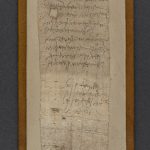| Artefact ID | 173 |
| TM ID | TM 10029 |
| Findspot (DEChriM ID) | 50 (Qaṣr Qārūn) | Class | Textual |
| Material | Papyrus |
| Writing medium | Sheet/roll |
| Text content | Documentary |
| Language | Greek |
| Archive/Dossier | Archive |
| Description | P.Abinn. 32; P.Lond. II 417; Chrest.Wilck. 129: Letter from a priest to Abinnaeus. Letter addressed to "his master and beloved brother Abinnaeus", from Kaor, priest of Hermopolis. The latter urges Abinnaeus to forgive Paulus, a soldier who had deserted, as Kaor is not able to pay a visit to Abinnaeus on that day.
Kaor, πάπας Ἑρμοῦ πόλεως, was a priest from the village Hermopolis in the south-west Fayum, rather than the nome metropolis of the same name, and Paulus, the soldier, was probably Christian because of his name and because Kaor intercedes for him to Abinnaeus (Luijendijk 2008: 97, n. 53).
On the question whether Abinnaeus, commander of the cavalry (praefectus alae) in Dionysias, was a Christian and for his relationship with monks and clergy, see Barnes 1985: 373-374, Choat 2006: passim, Luijendijk 2008: 35, n. 42, Kaiser 2015: 383, Choat 2017: 47.
|
| Selection criteria | Mention of Christian cult officials/institutions, Christian onomastics |
| Date from | 342 |
| Date to | 351 |
| Dating criteria | Dated to ca. 346 in ed. pr. According to Gallazzi (2015: 177-178), all of the dated texts of Abinnaeus archive are dated between 343 and 351 AD, that is, in the period in which Abinnaeus exercised his functions of praepositus of the castra (342-351). |
| Absolute/relative date | Relative date |
| Archaeological context | Purchased as part of a lot comprising Papyri 401-447 from the Reverend Chauncey Murch (b. 1856, d. 1907) on 15 May 1893 (British Library website). While it was previously thought that Fl. Abinnaeus' archive was found in Philadelpheia where he went to live after his retirement, Gallazzi 2015 argued that Fl. Abinnaeus should have left his papers in his office (or in his lodgings), in Dionysias, when he left the army and handed over the command of the castra to others. The material would have been recovered in Qaṣr Qārūn, at the end of the nineteenth century, by antiquities seekers or sebākh quarrymen and given to merchants of Medînet el-Fayûm, where they would have been intermingled with the documents recovered at Kharabet el-Gerza (Philadelphia), before reaching European collections. |
| Accession number | London, British Library, Pap 417 |
ARTEFACT IDENTIFIERS
Reference edition:
· Bell, Harold Idris, Victor Martin, Eric G. Turner and Denis van Berchem, 1962. The Abinnaeus Archive. Papers of a Roman Officer in the Reign of Constantius II. Oxford: Clarendon Press, no. 32.
Additional bibliography:
· Barnes, Timothy D. 1985. “The Career of Abinnaeus.” Phoenix 39, 368-374.
· Choat, Malcolm. 2006. Belief and Cult in Fourth-Century Papyri. Studia Antiqua Australiensia 1. Turnhout: Brepols.
· Choat, Malcolm and Maria Chiara Giorda. 2017. Writing and Communication in Early Monasticism. Texts and Studies in Eastern Christianity 9. Leiden-Boston.
· Gallazzi, Claudio. 2015. “Dove è stato ritrovato l’archivio di Abinneo?” Archiv für Papyrusforschung und verwandte Gebiete 61, 170-179.
· Kaiser, Anna Maria. 2012. “Die Fahndung nach Deserteuren im spätantiken Ägypten.” In Actes du 26e Congrès international de papyrologie, Genève 16-21 août 2010, ed. Paul Schubert. Genève: Droz, 381-390.
· Kenyon, Frederic G. 1898. Greek Papyri in the British Museum II. London: British Museum, 299-300, no. 417.
· Luijendijk, AnneMarie. 2008. Greetings in the Lord: early Christians and the Oxyrhynchus papyri. Cambridge, Mass.-London: Harvard University Press.
· Martin, Annick. 1996. Athanase d’Alexandrie et l’Église d’Égypte au IVe siècle (328-373). Rome, 652.
· Naldini, Mario. 1968. Il Cristianesimo in Egitto. Lettere private nei papiri dei secoli II-IV. Studi e Testi di Papirologia. 3. Firenze: Le Monnier, no. 40.
· Tibiletti, Giuseppe. 1979. Le lettere private nei papiri greci del III e IV secolo d.C.: tra paganesimo e cristianesimo. Milano: Vita e Pensiero, no. 24.
· Wilcken, Ulrich. 1912. Grundzüge und Chrestomathie der Papyruskunde, I Bd. Historischer Teil, II Hälfte Chrestomathie. Leipzig-Berlin, 129.


 Json data
Json data




